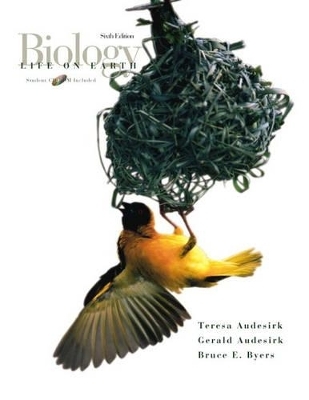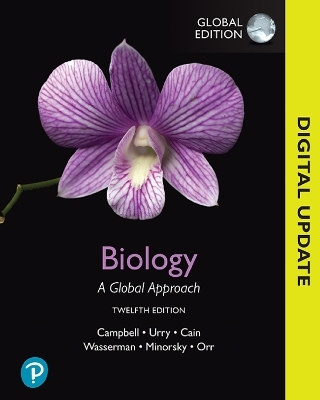
Biology
Pearson
978-0-13-089941-5 (ISBN)
- Titel erscheint in neuer Auflage
- Artikel merken
For one or two semester courses in Introductory Biology targeting non- and mixed majors.
The goal of this text is to provide an engaging and easy to use book with an innovative and interactive media program. It achieves a unique balance in emphasizing concepts without sacrificing scientific accuracy. The new MediaTutor, found at the end of each chapter, integrates the text and media by providing a brief description of the CD or WEB activity and the time requirement for completion. In creating the book and the media package, the authors and Prentice Hall reached out to the biology community—involving educators from around the country to help address the diverse needs of today's students.
1. An Introduction to Life on Earth.
Case Study: The Life Around Us.
What Are the Characteristics of Living Things? How do Scientists Categorize the Diversity of Life? What Is the Science of Biology? Evolution: The Unifying Theory of Biology. How Does Knowledge of Biology Illuminate Everyday Life?
Case Study Revisited: The Life Around Us.
I. THE LIFE OF A CELL.
2. Atoms, Molecules, and Life.
Case Study: Health Food?
What Are Atoms? How Do Atoms Interact to Form Molecules? Why Is Water So Important to Life?
Case Study Revisited: Heath Food?
3. Biological Molecules.Case Study: Improving on Nature?
Why Is Carbon So Important in Biological Molecules? How Are Organic Molecules Synthesized? What Are Carbohydrates? What Are Lipids? What Are Proteins? What Are Nucleic Acids?
Case Study Revisited: Improving on Nature?
4. Cell Membrane Structure and Function.Case Study: Vicious Venoms.
How Is the Structure of a Membrane Related to Its Function? How Do Substances Move Across Membranes? How Are Cell Surfaces Specialized?
Case Study Revisited: Vicious Venoms.
5. Cell Structure and Function.Case Study: Microscopic Stowaways.
What Are the Basic Features of Cells? What Are the Features of Prokaryotic Cells? What Are the Features of Eukaryotic Cells?
Case Study Revisited: Microscopic Stowaways.
6. Energy Flow in the Life of a Cell.Case Study: Energy Unleashed.
How Does Energy Flow in Chemical Reactions? How Is Cellular Energy Carried Between Coupled Reactions?
Case Study Revisited: Energy Unleashed.
7. Capturing Solar Energy: Photosynthesis.Case Study: Did Dinosaurs Die from Lack of Sunlight?
What Is Photosynthesis? Light-Dependent Reactions: Now Is Light Energy Converted to Chemical Energy? Light-Independent Reactions: How is Chemical Energy Stored in Glucose Molecules? What Is the Relationship Between Light-Dependent and Light-Independent Reactions? Water, CO2, and the C4 Pathway.
Case Study Revisited: Did the Dinosaurs Die from Lack of Sunlight?
8. Harvesting Energy: Glycolysis and Respiration.Case Study: The Flight of the Hummingbird.
How Is Glucose Metabolized? How Is the Energy in Glucose Captured During Glycolysis? How Does Cellular Respiration Generate Still More Energy from Glucose?
Case Study Revisited: The Flight of the Hummingbird.
II. INHERITANCE.
9. DNA: The Molecule of Heredity.
Case Study: Sunshine Perils.
How Did Scientists Discover That Genes Are Made of DNA? What Is the Structure of DNA? How Does DNA Replication Ensure Genetic Constancy?
Case Study Revisited: Sunshine Perils.
10. Gene Expression and Regulation.Case Study: Boy or Girl?
Case Study: How Are Genes and Proteins Related? How Is Information in a Gene Transcribed into RNA? How Is the Sequence of a Messenger RNA Molecule Translated into Protein? How Do Mutations in DNA Affect the Function of Genes? How Are Genes Regulated
Case Study Revisited: Boy or Girl?
11. The Continuity of Life: Cellular Reproduction.Case Study: Rattlesnake Surprise.
What Are the Functions of Cellular Reproduction? How is DNA in Eukaryotic Cells Organized into Chromosomes? What Are the Events of the Eukaryotic Cell Cycle? What Are the Phases of Mitosis? What Are the Events of Cytokinesis? What Are Some Advantages of Sexual Reproduction? What Are the Events of Meiosis? How Do Meiosis and Sexual Reproduction Produce Genetic Variability.
Case Study Revisited: Rattlesnake Surprise.
12. Patterns of Inheritance.Case Study: Sleepy Genes.
How Did Gregor Mendel Lay the Foundations for Modern Genetics? How Are Single Traits Inherited? How Are Multiple Traits on Different Chromosomes Inherited. How Are Genes Located on the Same Chromosome Inherited? How Is Sex Determined, and How Are Sex-Linked Genes Inherited? What Are Some Variations on the Mendelian Theme? How Are Human Genetic Disorders Investigated? How Are Human Disorders Caused by Single Genes Inherited? How Do Errors in Chromosomes Number Affect Humans?
Case Study Revisited: Sleepy Genes.
13. Biotechnology.Case Study: Teaching an Old Grain New Tricks.
What Is Biotechnology? How Does DNA Recombination Occur in Nature? How Does DNA Recombination Occur in Genetic Engineering Laboratories? How Can Researchers Identify Specific Genes? What Are Some Applications of Biotechnology? What Are Some Medical Uses of Biotechnology? What Are Some Ethical Implications of Human Biotechnology?
Case Study Revisited: Teaching an Old Grain New Tricks.
III. EVOLUTION.
14. Principles of Evolution.
Case Study: A Missing Link Unearthed.
How Did Evolutionary Thought Evolve? How Do We Know That Evolution Has Occurred? What Is the Evidence That Populations Evolve by Natural Selection? A Postscript by Charles Darwin.
Case Study Revisited: A Missing Link Unearthed.
15. How Organisms Evolve.Case Study: Cause of Death: Evolution.
How Are Populations, Genes, and Evolution Related? What Causes Evolution? How Does Natural Selection Work?
Case Study Revisited: Cause of Death: Evolution.
16. The Origin of Species.Case Study: Lost World.
What Is a Species? How Do New Species Form? How Is Reproductive Isolation Between Species Maintained? What Causes Extinction?
Case Study Revisited: Lost World.
17. The History of Life on Earth.Case Study: Life on a Frozen Moon.
How Did Life Begin. What Were the Earliest Organisms Like? How Did Multicellularity Arise? How Did Life Invade the Land? What Role Has Extinction Played in the History of Life? How Did Humans Evolve?
Case Study Revisited: Life on a Frozen Moon?
18. Systematics: Seeking Order Amidst Diversity.Case Study: Origin of a Killer.
How Are Organisms Named and Classified? What Are the Kingdoms of Life? Why Do Taxonomies Charge? Exploring Biodiversity: How Many Species Exist?
Case Study Revisited: Origin of a Killer.
19. The Hidden World of Microbes.Case Study: Agents of Death.
What Are Viruses, Viroids, and Prions? Which Organism Make Up the Prokaryotic Domains—Bacteria and Archaea? Which Organism Make Up the Kingdom Protista?
Case Study Revisited: Agents of Death.
20. The Fungi.Case Study: Three Outings.
What Are the Main Adaptations of Fungi? How Are Fungi Classified? How Do Fungi Affect Humans?
Case Study Revisited: Three Outings.
21. The Plant Kingdom.Case Study: Hunting for Medical Treasures.
What Are the Key Features of Plants? What Is the Evolutionary Origin of Plants? How Did Plants Invade and Flourish on Land?
Case Study Revisited: Hunting for Medical Treasurer.
22. The Animal Kingdom.Case Study: The Search for a Sea Monster.
What Characteristics Define an Animal? Which Anatomical Features Mark Branch Points on the Animal Evolutionary Tree? What Are the Major Animal Phyla?
Case Study Revisited: The Search for a Sea Monster.
IV. PLANT ANATOMY AND PHYSIOLOGY.
23. Plant Form and Function.
Case Study: A Beautiful Death Trap.
How Are Plant Bodies Organized, and How Do They Grow? What Are the Tissues and Cell Types of Plants? Roots: Anchorage, Absorption, and Storage. Stems: Reaching for the Light. Leaves: Nature's Solar Collectors. How Do Plants Acquire Nutrients? How Do Plants Acquire Water and Transport Water and Minerals? How Do Plants Transport Sugars?
Case Study Revisited: Beautiful Death Trap.
24. Plant Reproduction and Development.Case Study: What Are the Features of Plant Life Cycles?
What Are the Features of Plant Life Cycles? How Did Flowers Evolve? How Do Gametophytes Develop in Flowing Plants? How Does Pollination Lead to Fertilization? How Do Seeds and Fruits Develop? How Do Seeds Germinate and Grow?
Case Study Revisited: Walk Through a Meadow.
25. Plant Responses to the Environment.Case Study: A Chemical Cry for Help.
What Are Plant Hormones, and How Do They Act? How Do Hormones Regulate the Plant Life Cycle?
Case Study Revisited: A Chemical Cry for Help.
V. ANIMAL ANATOMY AND PHYSIOLOGY.
26. Homeostasis and the Organization of the Animal Body.
Case Study: The Limits of Endurance.
Homeostasis: How Do Animals Maintain Internal Constancy? How Is the Animal Body Organized?
Case Study Revisited: The Limits of Endurance.
27. Circulation.Case Study: Xenotransplants.
What Are the Major Features and Functions of Circulatory Systems? How Does the Vertebrate Heart Work? What Is Blood? What Are the Types and Functions of Blood Vessels? How Does the Lymphatic System Work with the Circulatory System?
Case Study Revisited: Xenotransplants.
28. Respiration.Case Study: Lives Up in Smoke.
Why Exchange Gases? What Are Some Evolutionary Adaptations for Gas Exchange? How Does the Human Respiratory System Work?
Case Study Revisited: Lives Up in Smoke.
29. Nutrition and Digestion.Case Study: Fat in the Family?
What Nutrients Do Animals Need? How Is Digestion Accomplished? How Do Humans and Other Mammals Digest Food.
Case Study Revisited: Fat in the Family?
30. The Urinary System.Case Study: Hemodialysis and Hope.
How Are the Functions of Vertebrate Urinary Systems? How Does the Human Urinary System Function?
Case Study Revisited: Hemodialysis and Hope.
31. Defenses against Disease: The Immune Response.Case Study: Fighting the Flu.
How Does the Boyd Defend Against Invasion? What Are the Key Characteristics of the Immune Response? How Does Medical Care Augment the Immune Response? What Happens When the Immune System Malfunctions?
Case Study Revisited: Fighting the Flu.
32. Chemical Control of the Animal Body: The Endocrine System.Case Study: Losing on Steroids.
What Are the Structures and Hormones of the Mammalian Endocrine System?
Case Study Revisited: Losing on Steroids.
33. The Nervous System and the Senses.Case Study: From Tragedy to Triumph.
What Are the Structures and Functions of Neurons? How Is Neural Activity Produced and Transmitted? What Are Some General Features of Nervous Systems? How Is the Human Nervous System Organized? How Does the Brain Produce the Mind? How Do Sensory Receptors Work? How Is Sound Sensed? How Is Light Sensed? How Are Chemicals Sensed?
Case Study Revisited: From Tragedy to Triumph.
34. Action and Support: The Muscles and Skeleton.Case Study: Healing Broken Bones.
How Do Muscles Work? What Does the Skeleton Do? Which Tissues Compose the Vertebrate Skeleton? How Dos the Boyd Move?
Case Study Revisited: Healing Broken Bones.
35. Animal Reproduction.Case Study: Mr. Mom?
How Do Animals Reproduce? How Does the Human Reproductive System Work? How Can People Limit Fertility?
Case Study Revisited: Mr. Mom?
36. Animal Development.Case Study: Far-reaching Choices.
How Do Indirect and Direct Development Differ? How Does Animal Development Proceed? How Is Development Controlled? How Do Humans Develop?
Case Study Revisited: Far-reaching Choices.
37. Animal Behavior.VI. ECOLOGY.
38. Population Growth and Regulation.
Case Study: Acorns, Mice, Moths, Deer, and Disease.
How Do Populations Grow? How Is Population Growth Regulated? How Are Population Distributed in Space and Time? How Is the Human Population Changing?
Case Study Revisited: Mice, Moths, Deer and Disease.
39. Community Interactions.Case Study: Invasion of the Zebra Mussels.
Why Are Community Interactions Important? What Are the Effects of Competition Among Species? What Are the Results of Interactions Between Predators and Their Prey? What Is Symbiosis? How Do Keystone Species Influence Community Structure? Succession: How Does a Community Change over Time?
Case Study Revisited: Invasion of the Zebra Mussels.
40. How Do Ecosystems Work?Case Study: Flight from Extinction.
What Are the Pathways of Energy and Nutrients? How Does Energy Flow Through Communities? How Do Nutrients Move Within and Among Ecosystems? What Is Causing Acid Rain and Global Warming?
Case Study Revisited: Flight from Extinction.
41. Earth's Diverse Ecosystems.Case Study: Wings of Hope.
What Factors Influence Earth's Climate? What Conditions Does Life Require? How Is Life on Land Distributed? How Is Life in Water Distributed?
Case Study Revisited: Wings of Hope.
Appendix I.Appendix II.Glossary.Photo Credits.Index.
| Erscheint lt. Verlag | 29.8.2001 |
|---|---|
| Sprache | englisch |
| Maße | 222 x 283 mm |
| Gewicht | 2316 g |
| Themenwelt | Naturwissenschaften ► Biologie |
| ISBN-10 | 0-13-089941-0 / 0130899410 |
| ISBN-13 | 978-0-13-089941-5 / 9780130899415 |
| Zustand | Neuware |
| Haben Sie eine Frage zum Produkt? |
aus dem Bereich



